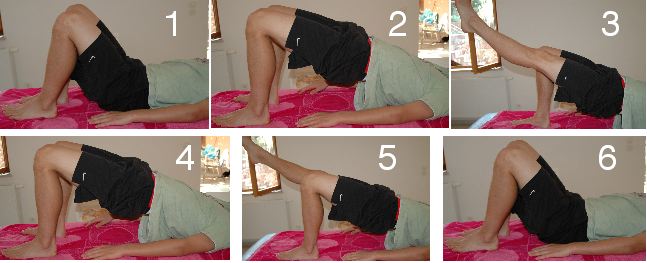It uses a concentric-eccentric pattern: the active muscles shorten concentrically as you lift the seat and straighten your knee, and then pay out eccentrically as you reverse the movement. The exercise helps train the co-ordination between your thigh muscles, hips, abdominals and back extensors. It shows up any imbalance between these major muscle groups.
Position: Lie on your back with your knees bent, feet free, and 1-2 pillows under your head, so that your neck is comfortably curved.
Movement: Tighten your abdominal muscles, tilting your pelvis backwards slightly, lift your hips, then straighten one knee to lift the foot into the air, pointing your toes and keeping your thighs level. Bend the knee to replace the foot on the floor, then straighten the other knee, keeping the hips up through the whole sequence.
Position: Lie on your back with your knees bent, feet free, and 1-2 pillows under your head, so that your neck is comfortably curved.
Movement: Tighten your abdominal muscles, tilting your pelvis backwards slightly, lift your hips, then straighten one knee to lift the foot into the air, pointing your toes and keeping your thighs level. Bend the knee to replace the foot on the floor, then straighten the other knee, keeping the hips up through the whole sequence.
Repetitions and frequency: Do the sequence 3-5 times at first, building up to 10-15 times, 1-2 times a day.

After injury: Following a hip, back, front-thigh, hamstring or knee problem, it is usually harder to balance on the side where the pain has been, so you should do more repetitions for that side to restore symmetry. As the legs are only supporting relatively little of your bodyweight, this exercise can be used at a fairly early stage following any leg injury which has made you limp or use crutches.


